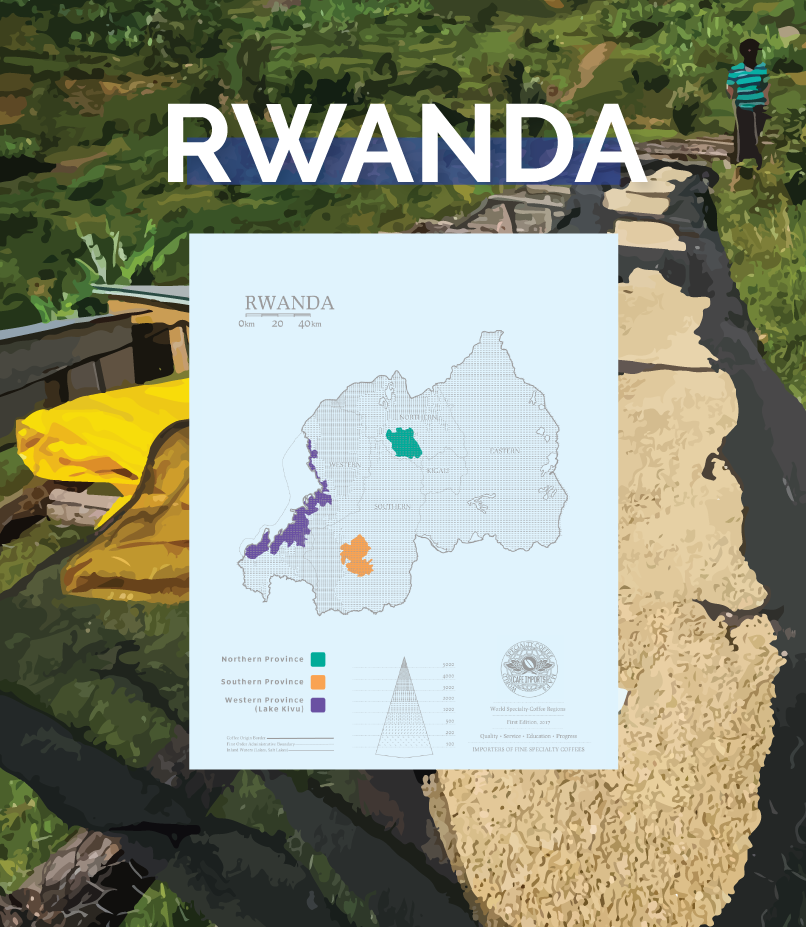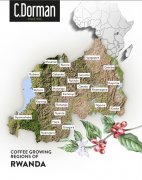Rwandan coffee beans taste characteristics| History of Rwandan Coffee Varieties and Their Harvesting
Rwanda is not a traditional coffee producing country, and the local people are not in the habit of drinking coffee. Almost 100% of the coffee produced is exported, with an annual output of more than 18000 tons, which is a huge number. So where do all these coffee beans come from?
The harvest season in Rwanda usually takes place from March to August. Due to changes in weather conditions, there is usually more production in April, but there are also cases where the harvest ends in July. The main coffee producing areas in Rwanda are Huye and Nyamagabe in the south, and Lake Kivu, Nyamasheke, Karongi, Gakene and Rutsiro in the west are all famous producing areas. the distance between producing areas is not far away, but the harvest time of different producing areas is still different because of the relationship between climate and altitude. Coffee farmers usually have small orchards, most of which are operated by their own gardens and self-picked families, while each household usually has no more than 200 fruit trees. Now that washing stations are all over the country, farmers will choose higher-priced ones or negotiate the price according to the market purchase price, and farmers with increased incomes have also begun to invest in producing appliances or buying more land to increase the number of coffee trees planted.

Western Province (WESTERN PROVINCE)
On the banks of Lake Kivu are some of the most famous washing plants in Rwanda, which steadily produce high-quality coffee with rich, fragrant, elegant and juicy taste.
Southern province (SOUTHERN PROVINCE)
The high-altitude terrain of the southern province of Rwanda creates the classic floral or citrus flavor of its coffee, as well as a delicate, delicate and sweet feel.
Eastern province (EASTERN PROVINCE)
The southeast of Rwanda, which has a small number of washing plants and coffee gardens, has come to the fore because of the rich chocolate and fruity aromas of the coffee produced.
Northern province (NORTHER PROVINCE)
Citrus, drupe and caramel flavors make coffee from the north and south of the province look balanced and sweet.
Rwandan coffee is also one of the best in East Africa, soft, sweet, floral and even, so it quickly captures the hearts of coffee fans around the world.
More than 90% of the varieties in Rwanda are mixed varieties of bourbon species and bourbon families introduced in the early stage, which already have the conditions for in-situ enhanced species (Land Race variety). In Central America, where most bourbon species are hit by leaf rust and other diseases, the advantage of bourbon in Central America is disappearing and is being replaced by newly cultivated hybrids amid years of chemical resistance by coffee farmers. In contrast, the Rwandan bourbon species still enjoy the advantages of flavor and strong species. The most common varieties in Rwanda include Bourbon Mayaguus 139 and Bourbon-Mayaguus 71 (i.e. BM139 and BM71) which still have old trees, some of which were introduced from Puerto Rico to the Congo and then introduced to Rwanda as early as the 1950s. Except for BM139 and BMT1. And Pp021. Legend has it that introduced by Guatemala, the Mibi and Jackson species are close to fast pickups (ascsoni also has a few Cauai. Caura 40 and Rwanda Harar, Rwanda.

Common varieties of Rwandan coffee-bourbon, French mission, Jackson, Mayaguus, Mibilis
Important Notice :
前街咖啡 FrontStreet Coffee has moved to new addredd:
FrontStreet Coffee Address: 315,Donghua East Road,GuangZhou
Tel:020 38364473
- Prev

Rwanda Pearl Project| How to drink coffee beans in Rwanda and the development history of its coffee industry
Rwanda Pearl Project| Rwanda's weight in the traditional coffee world is not as good as Kenya and Ethiopia, but in recent years its growing reputation has attracted the attention of international boutique coffee. Rwanda's coffee industry has a story, which is inseparable from government support. Rwandans have been living in Rwanda
- Next

The influence of Zhuoyue Cup on Rwanda Coffee Industry Flavor characteristics of washing treatment of Rwandan Coffee beans
The 2008 excellent Cup encourages coffee farmers to circulate and promote the ranks of high-quality beans. Before the introduction of the excellent cup, the vast majority of coffee in Rwanda was disorderly, there was no obvious difference in quality, and there was no specific description of the flavor characteristics of high-quality beans. After the introduction of the Excellence Cup, international experts began to record and discuss Jean Lew in depth.
Related
- Detailed explanation of Jadeite planting Land in Panamanian Jadeite Manor introduction to the grading system of Jadeite competitive bidding, Red bid, Green bid and Rose Summer
- Story of Coffee planting in Brenka region of Costa Rica Stonehenge Manor anaerobic heavy honey treatment of flavor mouth
- What's on the barrel of Blue Mountain Coffee beans?
- Can American coffee also pull flowers? How to use hot American style to pull out a good-looking pattern?
- Can you make a cold extract with coffee beans? What is the right proportion for cold-extracted coffee formula?
- Indonesian PWN Gold Mandrine Coffee Origin Features Flavor How to Chong? Mandolin coffee is American.
- A brief introduction to the flavor characteristics of Brazilian yellow bourbon coffee beans
- What is the effect of different water quality on the flavor of cold-extracted coffee? What kind of water is best for brewing coffee?
- Why do you think of Rose Summer whenever you mention Panamanian coffee?
- Introduction to the characteristics of authentic blue mountain coffee bean producing areas? What is the CIB Coffee Authority in Jamaica?

